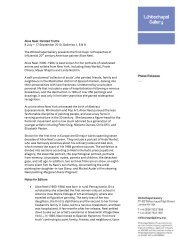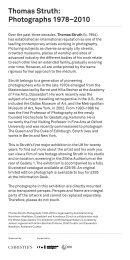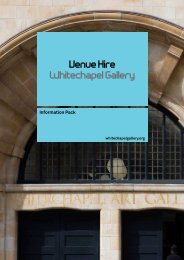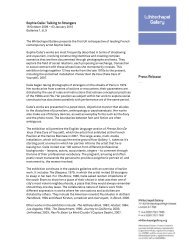Sophie Calle final edit 30 10 09 - Whitechapel Gallery
Sophie Calle final edit 30 10 09 - Whitechapel Gallery
Sophie Calle final edit 30 10 09 - Whitechapel Gallery
- No tags were found...
Create successful ePaper yourself
Turn your PDF publications into a flip-book with our unique Google optimized e-Paper software.
Conversationsand Actions<strong>Whitechapel</strong> <strong>Gallery</strong><strong>Sophie</strong> <strong>Calle</strong>:Talking toStrangers16 October 20<strong>09</strong>–3 January 20<strong>10</strong><strong>Whitechapel</strong> <strong>Gallery</strong>77–82 <strong>Whitechapel</strong>High StreetLondon E1 7QXAldgate Eastwhitechapelgallery.org
Conversations and Actions: <strong>Sophie</strong> <strong>Calle</strong>How to use Conversations and ActionsThis booklet has been written to help you explore the<strong>Whitechapel</strong> <strong>Gallery</strong> exhibition <strong>Sophie</strong> <strong>Calle</strong>: Talking toStrangers.It begins with a conversation between two artists, RebeccaGreathead and Daniel Wallis. Their conversation outlines keyideas about <strong>Sophie</strong> <strong>Calle</strong> and her work. This will support yourexploration of the exhibition , and give you information to passonto others whether you are visiting with children, young adultsor any other group. Their conversation continues throughout thebooklet, introducing you to each work in the exhibition. There isa map of the exhibition at the back.Throughout the booklet are actions that you can take in the<strong>Gallery</strong> that will help you think about the artist’s ideas, workingprocesses or more directly about the work. These are in greyboxes and can often be carried out individually or in smallgroups. They are guidelines so the actions are easily adaptableto suit a wide-range of people.Also within the booklet are actions that can be used beyond the<strong>Gallery</strong>. They are often more involved and can easily beexpanded upon to suit your own needs or that of the group youmay be working with.Spread throughout are images that you can display to act asprompts and help remind you of the exhibition.If you want to use these conversations and actions with a groupit may help to talk your ideas through with a colleague first tohelp you tailor it to fit.Have fun!1
Conversations and Actions: <strong>Sophie</strong> <strong>Calle</strong>DanielRebeccaDanielRebeccaDanielRebeccaDanielRebeccaDanielRebeccaDanielRebeccaDanielRebeccaDaniel<strong>Sophie</strong> <strong>Calle</strong> uses a lot of writing in her work, but she’s French isn’t she. So,why’s it all in English?Some works have been translated. The piece shown in the downstairs gallerywas first shown at the Venice Biennale where it was presented in French andItalian.She’s been making work for the last thirty years. Does she always make workabout people?<strong>Sophie</strong> often uses other people in her work, sometimes people she hasn’t met.At times it seems she manipulates others for her own creative ends, but she alsooffers opportunities and space for the creative input of others.How does she manage to get people to do all sorts of things for her?She often does something in return. She asked Damien Hirst to write her a loveletter as she claimed never to have received one before. He did so and it led to aseries of exchanges between the two of them.<strong>Sophie</strong> doesn’t just ask artists to collaborate with her though, she seems able toget all sorts of ordinary people to take on bizarre tasks.Maybe she captures people’s imagination or gives them license to do somethingthey would not otherwise do.Where her work involves people do you think it is about them or about <strong>Sophie</strong>herself?That’s something to think about when looking at each work.The texts that <strong>Sophie</strong> use take her a long time to compose. I think she definitelyhas a sense of humor, some of it is very funny.So are some of the images.The works are loaded with stories about the artist, about other people and aboutstories the artist has imagined about other people.She also invites other people to invent stories about her.Early in her career she was taking photographs around the Eiffel tower in Paris.She saw some gardeners laying turf and asked the head gardener if he wouldmind contacting her if they returned as she wanted to take photographs. Sixmonths later she received a phone call informing her of further work. She beganto wonder what was written in the diary next to her phone number to remind anear stranger who she was, and when to call her.RebeccaI guess we all wonder sometimes how we might be described by others.2
Conversations and Actions: <strong>Sophie</strong> <strong>Calle</strong><strong>Gallery</strong> 1: Take Care of YourselfDanielRebeccaDanielRebeccaWhat do all these women have in common? I’ve spotted that they have all sorts ofdifferent jobs – it lists them on the walls. There is a Chess Player, a Clairvoyant, a DJ anda rifle shooter...<strong>Sophie</strong> gave them all a copy of an email from her lover breaking off their relationship andasked them to interpret the message in whatever way they felt was appropriate to theirprofession, there are <strong>10</strong>7 responses.Using email isn’t a very personal way to end a relationship. Is there a copy of itanywhere? I’d like to see how he wrote it.There are a few full copies of it on display. I like the Rifle Shooter’s response – you cansee the whole email printed out, but she has shot through the word love. Go and have alook…Look at some of the responses closely before finding out from the text near the ceiling what is theprofession of the person who made it has.Can you guess what they do?Once you know their profession, what elements of their response match their job?Could you make a visual response that reflects your profession, hobby or personal interests?Choose a job from amongst those listed around the gallery.Play charades and act out that profession for the others to guessWhy did you pick that job?Have a longer look at the responses in the gallery that are people performing readings of the email.Are the various women simply reading it out, imagining they are <strong>Sophie</strong>, or taking on the role of the manwho wrote it?Think of different ways to act out the content of the email.You may need to simplify its message first:e.g. I still love you but I no longer want to have a relationship could become I don’t love you anymoreA good starting point is to look at how the 9 year old girl at the far end of the gallery (labeled above asSchoolgirl) has made her summary.Do you think the man who wrote the email has been cruel to <strong>Sophie</strong>?Is <strong>Sophie</strong> presenting a balanced view?Do you think she felt better after having made the artwork?Do you think all these women felt sympathy for her?How do you think the author of the email would feel walking around the gallery?Select a text to begin with – it could be real or made-up, a poem, an email, a phone text, a story or aphrase.In groups each make a different interpretation – a dance, a collage, a song, a play, a diagram etc.3
Conversations and Actions: <strong>Sophie</strong> <strong>Calle</strong><strong>Gallery</strong> 9: Couldn’t Capture DeathDanielRebeccaRebeccaIn this first work upstairs <strong>Sophie</strong> attempted to record her mother’s last acts before shedied. The film was intended to capture her last moments of life and the first of death. Inthe end it was impossible to determine the point at which one became the other.It’s very sad. Your last moments could equally be chance, or planned as with <strong>Sophie</strong>’smother, Monique, selecting the things she wanted to do for the last time. There’s a liston the wall.It’s just like <strong>Sophie</strong>’s artwork. There may be a firm plan, rules or instructions- in thiscase, to record her mother’s passing - but there is still much chance and fortuity. Theworks in the next room have the guiding rule written high up above them.<strong>Gallery</strong> 8: The BronxDanielRebeccaDanielRebecca<strong>Sophie</strong> refers to the next three pieces as ‘Journeys’. According to this instruction sheasked passers-by in this notorious no go district of New York to take her to a place thatwas meaningful to them.The text in the frames explains where they took her and the things they told her. Oneman took her to a bank as it was his ambition to have a bank account. Another homelessperson took her to the house he had grown up in.They made really meaningful choices. I wonder where I would take her in my hometownthat means something to me. Why is there writing all over the work?Someone broke into the gallery where it was first shown and covered the work and wallsin graffiti. <strong>Sophie</strong> decided to leave it as she thought it made the work better. Others maycall that person a vandal, but she describes them as an unexpected collaborator.Which special place would you take a stranger to? Why?Describe it to someone else.Lots of people seem willing to take part in the requests <strong>Sophie</strong> makes.Would you take a stranger somewhere if they asked you to?What would you get out of doing this?Would you want to go somewhere with a stranger?Do you think this was a safe thing for <strong>Sophie</strong> to do?What do you think she was trying to achieve through this?How would you feel if someone wrote over your artwork?Take someone to a place within your local or immediate environment and describe why you selected it.Ask other people to take you to nearby places and record the reasons for their choices.Had you noticed any of these places before?Do they seem different to you now?Does doing this reveal to you anything about yourself?4
Conversations and Actions: <strong>Sophie</strong> <strong>Calle</strong>Photograph from Anatoli, 1984, 19 x 24cm5
Conversations and Actions: <strong>Sophie</strong> <strong>Calle</strong>From Gotham Handbook, 1990, colour photo mounted on aluminium, 180 x 120 cm7
Conversations and Actions: <strong>Sophie</strong> <strong>Calle</strong><strong>Gallery</strong> 8: The DetachmentRebeccaDanielRebeccaDanielRebeccaThese books contain conversations <strong>Sophie</strong> had with people about their memories ofmonuments that were removed after the Berlin wall came down.I only have vague memory of that happening.In 1989 the people of Berlin tore down the wall that had divided it for nearly <strong>30</strong> years. Itformed part of the border set up by the communist East German government to divide itfrom West Germany. The books also have an image of the actual monument. You need topeer round the pages to see as the books mark easily and should not be touched.It’s interesting how the missing monuments are replaced with the described memoriesof people who were there, but they can’t quite remember what the monuments actuallylooked liked.But they do remember what they stood for?Can you tell from the photographs that something has been removed?How?Describe a monument you would like to see there instead.Play the ‘memory game’ – get your group to look for a few minutes at a number of objects placedtogether and try to remember what is there. While no-one can see, take one of the objects away.Do people know which one has gone?Can they describe it?<strong>Gallery</strong> 8: Gotham HandbookRebeccaDanielRebeccaHere <strong>Sophie</strong> has asked the Writer Paul Auster to give her a set of instructions to follow.Amongst other things he asked her to look after a chosen place, and to smile atstrangers.She has chosen a phone booth as her ‘place’, look there is a big photograph of how itlooked when she tried to make it better. There are books and tissues, welcome bannersand even a banana! It is quite funny how she describes having to practice smiling atpeople before she could do it convincingly.It is an attempt to improve people’s lives.Set each other three simple rules to follow when moving around the gallery:This might involve other visitors to the gallery, smiling at people or taking the same route as anotheraround the artworks.It might be about how to view the artwork: through one eye, for exactly five minutes or on one leg.Cultivate a spot in your local or immediate environmentTake responsibility for it, clean it, make it more pleasantSpend time watching and recording what happens there, see if you learn anything8
Conversations and Actions: <strong>Sophie</strong> <strong>Calle</strong><strong>Gallery</strong> 8: The SleepersRebeccaDanielRebeccaThis was made <strong>30</strong> years ago, before <strong>Sophie</strong> called herself an artist. She asked people tosleep in her bed for shifts – one in as one gets out.I like the documentary style. She writes that she offered clean sheets to people butsome weren’t worried about this and others wanted to know who had previously been inthe bed before deciding.There was no reward offered to people to do this but she still found enough to fill the bedfor a week, including people she had never met before. There is a lot of trust in invitingpeople you don’t know to sleep in your bed, but also trust from them for falling asleep ina stranger’s bed knowing you will be photographed.A bed can be a place of safety or of sickness. How is your bed important to you?Look at the way <strong>Sophie</strong> describes the actions of the people in her bed. Can you mirror her style?Watch or follow a visitor for a few minutes as they move around the gallery and record their actions. Thiscould be by writing, drawing or just in your memory.What are the important, boring, and interesting things to describe?What can you leave out? What must you put in?Why did you pick that person?How would you feel if you discovered someone was following you and describing your actions?Occupy a new space. A chair you never sit in, under a table, in a cupboard. How does it feel?Watch someone occupy a different space. How do they look different?Find a place to occupy for a short time that you might not normally be allowed, the teachers desk,someone’s study, in the loft. You will need to ask permission, you may need to offer something in return,use of your own private space, a favour.Imagine that someone else is following you and recording your actions. Try to describe what they mightnoticeGet a friend to follow you and take photographs. Use these to describe your actions.<strong>Gallery</strong> 8: Journey to CaliforniaRebeccaDanielRebeccaA man wrote to <strong>Sophie</strong> after his long-term relationship ended asking if he could spendthe rest of his time grieving the relationship in her bed.Sounds like just the sought of thing she’d be interested in.Actually, she thought it was a bit of a tricky request to deal with. You can see why in theletters. But she did send him her bed so his request was fulfilled.Having looked at a number of <strong>Sophie</strong>’s works now you must have formed an opinion of what she isinterested in and what sort of person she is.What would you ask her to do for you?What would you ask to do for her?How would you ask her? By email, phone, text, letter or another way?9
Conversations and Actions: <strong>Sophie</strong> <strong>Calle</strong><strong>Gallery</strong> 8: The Address BookDanielRebeccaDanielRebeccaDanielRebeccaI’ve heard about this artwork before, it is one of <strong>Sophie</strong>’s earliest and most famousartworks.I wouldn’t have the nerve to take a stranger’s address book, call their friends and thenpublish those conversations about the stranger in a national newspaper.He had been on holiday and was very angry when he returned and found out.I am not surprised, I would be too!<strong>Sophie</strong> felt she had gone too far and crossed a line with this work. From then on sheresolved to try and use herself more as the object of her artwork rather than riskexploiting others.Perhaps it is her most infamous work!The images in the newspaper relate to something that <strong>Sophie</strong> felt emerged during her conversations.Find a conversation to eavesdrop. Draw and doodle whilst listening. Try not to focus on illustrating thenarrative, just pull out images from what is being said.If you are in a large group divide into groups of five.Pick one person in each group to be your ‘stranger’.Everyone in the group should write one word/draw one image that describes the ‘stranger’ or the‘stranger’s’ personality or interests. The ‘stranger’ should do this too.Reveal your descriptions to the other groups – can they work out who your ‘stranger’ is.What aspects/elements of a person can you choose to describe them?Think about the many ways that your descriptions could be wrongly interpreted?<strong>Gallery</strong> 8: Cash Machine/UnfinishedDanielRebeccaDanielWhat about this piece around the corner then showing images of people using a cashmachine. They don’t look to me as though they are aware of being caught on camera.A bank commissioned this piece and gave her the images to use. She tried finding a wayto add text to the images for many years including seeing a hypnotist but was not happywith anything she tried. In the end she decided it could stand as it was - a monument tofailure.You could say that these images are stolen. Having them in the gallery like this raises alot of questions about personal privacy and ideas of a surveillance state.What do you think some of these people are thinking about whilst they are using the cash machine?Do you think all of them were able to withdraw money?Why does the bank have security cameras at its cash-points?Would you feel comfortable with images such as these of you being shown in a gallery?How do you feel about security cameras?What is it about <strong>Sophie</strong>’s work that prompted the bank to choose her to commission?<strong>10</strong>
Conversations and Actions: <strong>Sophie</strong> <strong>Calle</strong>From Take Care of Yourself, 200711
Conversations and Actions: <strong>Sophie</strong> <strong>Calle</strong>DanielRebeccaDanielRebeccaDanielRebeccaDanielRebeccaDanielRebeccaDanielRebeccaIt seems that <strong>Sophie</strong> is always looking for someone to tell her what to do. Buthow does she choose? There must be people suggesting things to her all the timenow she’s so well known.She won’t do just anything, it has to fit in with the ideas she wants to pursue.Do you think she invites suggestions so as to have more ideas to choose from?I went to an exhibition she had in 1999 and there was a suggestion box from<strong>Sophie</strong> requesting ideas for an activity she might undertake. I asked her to DJ atmy wedding.Did she?No!Some of her more recent work has involved enacting errors that journalists havemade about her.What do you mean?Well, for example if someone has mistakenly written that she works with deafpeople then she goes and works with deaf people.Oh, so instead of getting annoyed she looks for mistakes and turns them into agame.I hope we haven’t made any mistakes?I hope we have!12
Conversations and Actions: <strong>Sophie</strong> <strong>Calle</strong>To book your group visit anduse of our Education Space(Tuesday, Wednesday andThursday during term time)please call EducationOfficer on 020 7522 7894 oremailrostaylor@whitechapelgallery.orgSee exhibitions page ofwebsite for <strong>Sophie</strong> <strong>Calle</strong>interpretation leafletwww.whitechapelgallery.org13
















